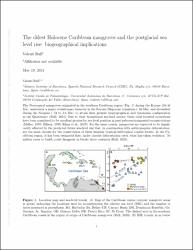/admin/item?itemID=74019e89-3076-42fa-ba1b-0e2544dbb370
The oldest Holocene Caribbean mangroves and the postglacial sea level rise : biogeographical implications

View/
Type of Access
OpenMaterial Type
ArticleType of Content
Scientific researchLanguage
EnglishCollection
- Investigación ambiental [1759]
Metadata
Show full item record| Abstract: | The Neotropical mangroves originated in the southern Caribbean region during the Eocene (50-40 Ma), underwent a major evolutionary turnover in the Eocene/Oligocene transition (~34 Ma), and diversified during the Neogene (~23 to 2.6 Ma), to attain their present biogeographical and taxonomic configuration in the Quaternary. Due to their transitional sea-land nature, these tidal forested ecosystems have been considered to be excellent proxies for sea-level position in past paleoenvironmental reconstructions. For the same reason, mangroves are expected to be significantly affected by the predicted future sea-level rise that, in combination with anthropogenic deforestation, are the main threats for the conservation of these singular tropical/subtropical coastal forests. In the Caribbean region, it has been estimated that, under current deforestation rates, what has taken evolution ~50 million years to build, could disappear in barely three centuries... |
| Author(s): | Rull, Valentí
|
| Date: | 2024 |
| Published: | ESS Open Archive [preprint] |
| Citation: | Rull, V. (2024). The oldest Holocene Caribbean mangroves and the postglacial sea level rise: biogeographical implications [preprint]. ESS Open Archive. Recuperado de: |
| URI: | https://bvearmb.do/handle/123456789/4666
|

